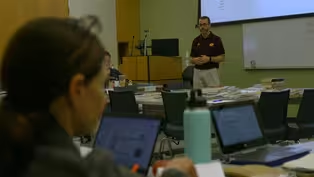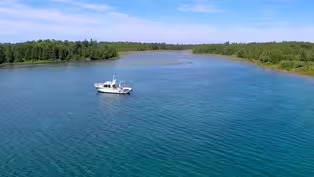Pressing Matters
Microplastics
Clip: Season 1 Episode 1 | 9m 20sVideo has Closed Captions
Exploring microplastics in our water
Exploring microplastics in our water
Problems playing video? | Closed Captioning Feedback
Problems playing video? | Closed Captioning Feedback
Pressing Matters is a local public television program presented by WCMU
Pressing Matters
Microplastics
Clip: Season 1 Episode 1 | 9m 20sVideo has Closed Captions
Exploring microplastics in our water
Problems playing video? | Closed Captioning Feedback
How to Watch Pressing Matters
Pressing Matters is available to stream on pbs.org and the free PBS App, available on iPhone, Apple TV, Android TV, Android smartphones, Amazon Fire TV, Amazon Fire Tablet, Roku, Samsung Smart TV, and Vizio.
Providing Support for PBS.org
Learn Moreabout PBS online sponsorshipAnother threat to our health and waterways are microplastics.
These tiny particles are a growing concern because they're being found everywhere in our water, soil, and even in the air that we breathe.
So what exactly are they and why should we care?
Research on microplastics is still pretty new, but here's what we know.
They're small, less than five millimeters in size.
They can come from a variety of sources, including the breakdown of larger plastic items.
They can also be used in some personal care products.
And there's synthetic fibers that are released when we wash our clothes.
They're so small that they can be ingested by animals and can potentially enter the food chain.
To learn more about microplastics today, here is Dr. Amanda Suchy researcher with CMU's Institute for Great Lakes Research.
Amanda, thank you for being here today.
- Thank you.
- Amanda, you've spent a lot of time studying microplastics.
There's something that people have been aware of since the, I believe, the 1960s, but why is there such a sense of urgency now to understand them better?
- I think that there's a sense of urgency now because we're really realizing how prevalent they are and widespread.
I mean, we're finding them in places that we would consider untouched by people, right?
Bottoms of the oceans, tops of mountains.
And a lot of research previously had been done in oceans and in the past 10 years or so, there's been much more focus on fresh water.
And so we're realizing, oh, they're in the Great Lakes as well, and they're there in pretty reasonably large quantities or quantities that we make need to be concerned about.
- Right?
Right, so how do they get there?
How do they get into our ecosystems?
- Yeah, they can get there through a variety of different pathways.
So one common one, and this is how they get to places like mountaintops, is it's in the dust, right?
And so it moves in the air and can travel really far distances and then get deposited in places that might be far from the sources of those microplastics.
Another way that they can get into ecosystems, in particular aquatic ones like the Great Lakes is runoff during storms.
And so you have water coming down, flushing stuff into rivers, and that water carries things and it can carry microplastics into the rivers and ultimately end up in the Great Lakes.
Roadways and tire fragmentation are a source.
And then of course, as you mentioned, fibers from our clothing, washing machines ending up in our treatment plants that can discharge into the waterways as well, a lot of different ways.
- [Stefanie] That's something that I never would've even considered, right?
- I didn't until I was started researching this, as well.
Yeah, so.
- Absolutely.
Well, according to EGLE which is Michigan's Department of Environment, Great Lakes and Energy, there was a national study that found that the highest concentration of microplastics was found at the Apostle Islands National Lakeshore, in Wisconsin.
I'm pretty sure that's a very remote location, but why do you think that is?
- You know, I'm not really sure.
We don't really know, but I can say that we do see that trend beyond the Apostle Islands.
That Lake Superior compared to Lake Michigan and Lake Huron do seem to have more microplastics.
It's not completely clear why yet, and this is the case in terms of the sediments, what we find in the wetlands, and it doesn't matter how remote they are.
My most remote sites were in Lake Superior and had some of our highest concentrations.
- [Stefanie] Really?
- Yeah.
So it's definitely something that needs more work and better understanding.
- Absolutely.
So do we know what the impact of microplastics is on water quality and the life in the Great Lakes?
And of course, how does this affect us as people and our ecosystems?
- Yeah, so that's a big question and one that we don't have a very clear answer to yet.
As you've mentioned, the work on microplastics has really exploded in the past five years.
And despite that explosion, there's still so many unknowns.
And what people are trying to work towards is what is that threshold of effect, right?
When do microplastics become a problem?
But that can depend on the type of microplastic.
Is it a fiber or fragment?
How big is it?
Because if it's a big piece, an animal can ingest it and expel it, but if it's super, super small, it could be ingested and then translocate into different tissues in their body.
So move around.
And so the size matters and so we're talking about various types of effects that can be on, that microplastics can have on organisms.
One that's a bit more clear is we know that it can cause what we call food dilution, or they ingest microplastics along with food.
Their stomachs feel full, but they're not getting the same amount of nutrition that they would if that stomach was full of food and not partial microplastics.
Some were looking at the threshold of effect at that in aquatic systems that we have reached that.
And so we do have risk of food dilution occurring in aquatic organisms.
In terms of that movement of microplastics in throughout our bodies or toxicity that is still really, really unknown in terms of what that level of toxicity is.
- Sure.
- Yeah.
- But it's pretty safe to assume that a lot of people probably have a level of, or are consuming maybe unintentionally of course a level of microplastics, right?
- Absolutely.
Yeah.
And in terms of human effects, that is also very unknown.
Yeah.
And so the amounts that we are likely consuming on a day-to-day basis, as of now, we're not seeing much evidence that that's harm, but we still just know so very little, you know, general inflammation responses and such that could be caused by these types of things that are very hard to pin down.
- So what kind of research is there available right now about the impact on our long-term health?
Is it something that we're still studying?
- Yes, it's very much something that we're still studying and trying to understand.
- We did reach out to EGLE and they're also studying and monitoring microplastics, of course, but it comes with challenge.
So I'm gonna read a little bit from a statement that they sent us, they said that EGLE staff are continuing to follow current scientific literature on the topic of microplastics and nano-plastics in the Great Lakes.
Internally, they're considering appropriate methods for monitoring microplastics in the water.
And this is challenging when it compares to other pollutants.
So my question for you, after reading that is how do microplastics compare to other pollutants in the Great Lakes.
- Right now, I would say that other pollutants such as PFAS, and even when we talk about nutrient pollution like nitrogen, a phosphorus that cause those algal blooms.
One, we know a bit more about those, and I say that they're a bit more of an immediate concern, right?
They have those algal blooms are detrimental.
We know what causes them.
PFAS we know is very harmful and as in concentrations that we know can be harmful in the lakes, the microplastics is still an emerging concern and its concentrations may not be quite as high or of that level yet, which means we have a good opportunity to prevent that from happening.
You know, so another aspect with microplastics and other pollutants is how they might interact with each other.
So microplastics are sticky and so they can absorb or absorb these other pollutants onto them and potentially transport them elsewhere.
And so that's another thing that people are looking into is like, okay, is that a, an additional risk from microplastics if they're interacting with other pollutants like PFAS?
- So as we are trying to find a way to get a handle on this, do you think, you know, do you think legislation is something that can help manage this?
- Yeah, I think legislation could offer some help.
I mean, one of the primary ways that fibers get into the system is through the washing of our clothes and discharging of that into our treatment plants.
Simple filters on our washing machines could filter out a good majority of those particles.
So it's a really easy way to stop at the point source of that pollution discharge into the environment.
Whether that's legislation or people choosing to add those onto their washing machines and the reduction of single use plastics are always beneficial.
Anything that would prevent those from getting into the environment would reduce microplastics in the environment as well.
- Yeah, you're hitting the nail on the head here for my final question.
I was gonna ask, you know, what can we as people do now to try and reduce the amount of microplastics entering our environment?
Reducing single use, what else?
- Yeah, reducing single use plastics, using as much reusable items as you can.
Plastic has changed our world and will not go away and should not go away, but if we are able to change some of the items that we use, whether it's more cardboard in place of plastics where we can or make that choice use more reusable items, and if we're able to adapt our washing machines, those are the most immediate ways that we can start to reduce inputs into the environment.
- Well, microplastics are not going away anytime soon, but we can all do our part to reduce the amount that is circulating in our environment.
Dr. Amanda Suchy, thank you so much for being here today.
- Thank you.
(upbeat music)
Artificial Intelligence in the Classroom
Video has Closed Captions
Clip: S1 Ep1 | 6m 55s | Artificial Intelligence in the Classroom (6m 55s)
Video has Closed Captions
Clip: S1 Ep1 | 8m 41s | Water Quality and PFAS in Michigan's water ways. (8m 41s)
Providing Support for PBS.org
Learn Moreabout PBS online sponsorship
- News and Public Affairs

Top journalists deliver compelling original analysis of the hour's headlines.

- News and Public Affairs

FRONTLINE is investigative journalism that questions, explains and changes our world.












Support for PBS provided by:
Pressing Matters is a local public television program presented by WCMU

